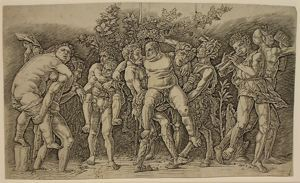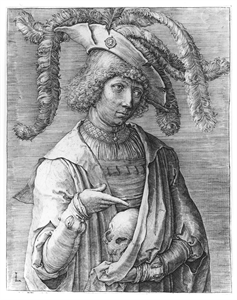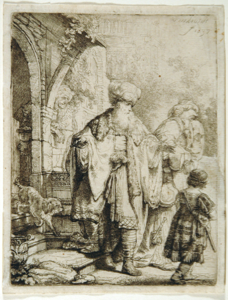
Andrea Mantegna
Italian, 1431–1506
Mantegna’s work features strong contours shaded mainly by emphatic diagonal hatching. He used a “slip stroke,” dragging the burin across the plate as he passed from one line to the next and created a zig-zag effect that is visible in hatching on the legs of Bacchus. The frieze-like composition of many of his prints, in which the action takes place in a shallow space parallel to the picture plane, is inspired by classical relief sculpture, evidence of the fifteenth century’s renewed interest in the art of the Roman Empire. See "Dürer, Rembrandt, and Beyond from the Collection of Mr. and Mrs. Adolph Weil, Jr.," exh. cat. (Montgomery: Montgomery Museum of Fine Arts, 1994,) 8.
Italian, 1431–1506
Bacchanal with Silenus
about 1475-1480
Object Type:
Print
Creation Place:
Southern Europe, Italian
Dimensions:
10 3/8 in. x 17 5/16 in. (26.35 cm x 43.97 cm)
Medium and Support:
Engraving on paper
Accession Number:
1999.0007.0042
Credit Line:
Gift of Jean K. Weil in memory of Adolph "Bucks" Weil, Jr.
Mantegna’s work features strong contours shaded mainly by emphatic diagonal hatching. He used a “slip stroke,” dragging the burin across the plate as he passed from one line to the next and created a zig-zag effect that is visible in hatching on the legs of Bacchus. The frieze-like composition of many of his prints, in which the action takes place in a shallow space parallel to the picture plane, is inspired by classical relief sculpture, evidence of the fifteenth century’s renewed interest in the art of the Roman Empire. See "Dürer, Rembrandt, and Beyond from the Collection of Mr. and Mrs. Adolph Weil, Jr.," exh. cat. (Montgomery: Montgomery Museum of Fine Arts, 1994,) 8.
Keywords
Click a term to view the records with the same keyword
Portfolio List
Click a portfolio name to view all the objects in that portfolio
This object is a member of the following portfolios:
Your current search criteria is: Keyword is "IL".

 by Artist (18)
by Artist (18)

